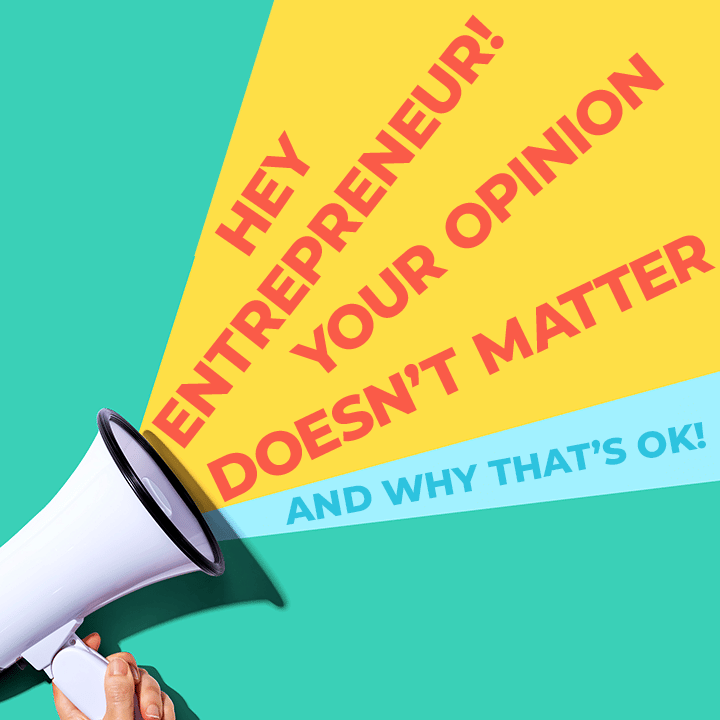Hey Entrepreneur, Your Opinion Doesn’t Matter, And Why That’s OK!
How impact startups can leverage design
Contrary to popular opinion design of your brand has little to do with personal taste and if you like it.
It is less about making a statement about yourself and more about how it will be used as a tool to drive you to your business goals.
How you approach your brand design will impact its outcome
Imagine you’ve just moved into your new home and it’s perfect. An exciting new chapter. It just needs that little something. The walls are bare so you decide to buy a painting. You flick through an online catalogue and land on something that feels right. The colours, the composition, the line work, and the expression feels like it represents you. You add it to the cart and wait for it to arrive.
Now imagine your exciting startup is really taking off, you’ve got the cash injection in the form of that much-needed investment. You look at your tired visual brand design, and — although it has warm feelings of nostalgia, from when you were that scrappy little startup — it’s time for a change. You want a look that represents where you are now.
You take the same approach you did when you bought that painting for your wall. You’ll settle with a brand design that you like and that’s the end of it. Job done.
However, this approach can cause many problems. Let’s take a look…
Scenario 1: Guided by personal preference with no strategic goal in sight
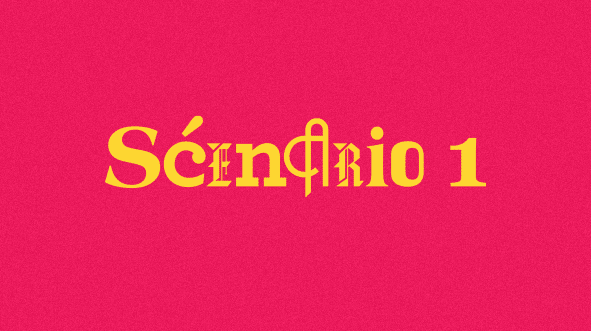
Decision:
You use a subjective approach and base all design decisions on personal taste. You skipped the brand strategy as it’s a waste of time and “let’s just cut to the chase and get on with the design refresh”.
Outcome:
The visual identity of your brand is hard to pin down. It becomes a nightmare of revision after revision because there is no goal, apart from vaguely looking good to you.
In addition it may or may not land with your customer which is a huge risk. And if you do attract them you’re not connecting on a level deeper than design aesthetics.
Mistake:
To focus on yourself. While it’s important for you to feel confident in your brand and you may be a similar demographic as your customers, the focus should be on your customers and their struggles and challenges.
Lessons:
As much as the brand is your own creation, you need to remove yourself from the branding situation. It’s in equal parts on how you want to represent yourself as a company and what you want to be known for as well as about what your customer needs. And both of these are directed by your business goals and not what you think it should look like in your head.
Scenario 2: A mish-mash of visual preferences
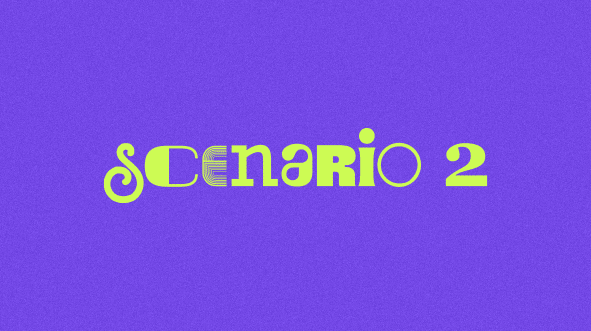
Decision:
You’re excited to work on your brand identity. Working with a branding studio takes you back to being in a sweet shop when you were young. You’re mesmerised by ‘shiny objects’; colour combinations, cool fonts and endless possibilities.
Outcome:
You can’t stand a particular green, it reminds you of a swamp, so you change it and it throws off the visual balance of the entire design. You love logos huge. You have a preference for not using full stops. (Yes this actually happened!). You like to ‘tweak’ font sizes of headings, sub-headings and all the spaces in between. Personal preferences dictate the colour palette, the choice of imagery, or the fonts used.
This approach leads to you playing the role of an art director. You choose the creative combinations and end up cooking up a monstrosity. You’re frustrated that it’s not working, “Surely putting together the colours, fonts and images that I like should work, right?”
Mistake:
When developing visual concepts, you offer solutions to the problems you see. From your perspective, you are offering a helping hand to your branding studio.
Lessons:
It is best to think ‘problems’ or what’s not working and why (devoid of personal preference). Stay top-level and goal-focused, instead of getting into the minutia. This is a very productive way of giving feedback and will speed up the process.
There is a certain level of professionalism and best practices that a trained designer can help you with. Allow the branding studio to take these decisions off your hands and bring their expertise to the table. This is what you are paying them for; solutions.
As a startup you must use your investment wisely. It’s financially inefficient to keep trying out ideas without a plan of where you are going. It’s a brilliant way to burn cash. Instead leverage your expert and their experience and save yourself the time and money.
Scenario 3: Asking for too many opinions or uninformed opinions
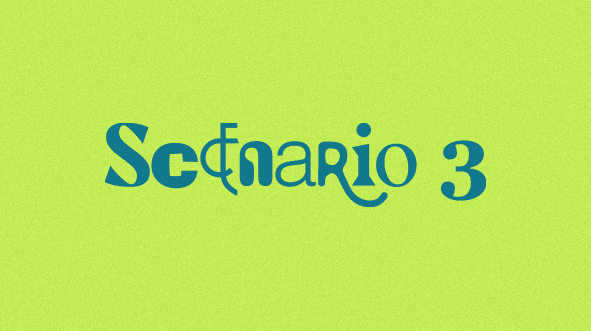
Decision:
To be diplomatic with the design at the expense of the final outcome.
Outcome:
You ask around the office and you get a variety of feedback. You relay all of this back to your branding studio, even if there are contradictions.
You end up compromising and creating a visual Frankenstein when you design by committee and even you, are not happy.
Customers are also indifferent or disenchanted with your brand as it doesn’t speak to them.
Mistake:
You want buy-in from the whole team. Keep everyone happy, with no push-back.
Lessons:
As a founder, it is understandable that you want to gather all possible great ideas — as many as you can get. But, constantly asking for feedback from too many people both internally and external can cause problems.
Understand that you won’t please everyone in the company. Having opinions from people not informed about your strategy findings will make judgements without context.
As a result, it can create friction in the working relationship with your branding studio. They may feel like you don’t trust their expertise and or you are undermining the collaborative work done together in the strategy phase.
Be open to collaboration, but don’t overdo it. Creating without context early on will be confusing to a customer later on.
Either only take opinions from those key stakeholders who were present in the brand strategy sessions. Or take all opinions and ideas from the team and qualify them through the agreed-upon brand strategy before relaying this back to your branding studio.
Scenario 4: Post-strategy feedback based on subjective opinion
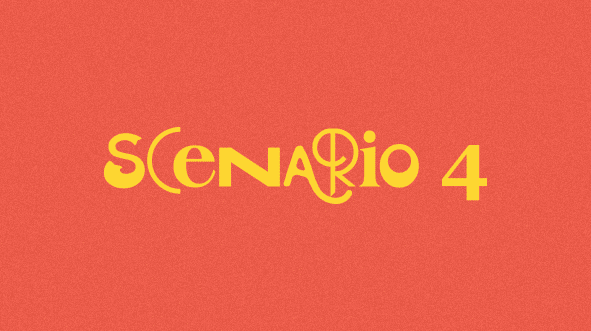
Decision:
Making an evaluation of the work completed based on personal preference.
Outcome:
Personal preferences dictate the creative direction resulting in the design work veering off course. The visual identity is misaligned with what was defined in the brand strategy. There is now a disconnect and it no longer fulfils its purpose.
This puts you at risk of not connecting with your customer at all. This is a missed opportunity as these customers would have otherwise turned into a lead.
This approach also lacks long-term brand stability because it is at the mercy of whoever is in charge at the company at the time of formulating this brand identity, rather than the customer.
Mistake:
Not using the strategy as a metric to measure the work.
Lessons:
Remember strategy leads to design, they don’t work in isolation. Compartmentalising the process is an incorrect way to approach branding. Think of it as dominoes, that one thing leads to the next.
Constructive feedback is when you employ your brand strategy to inform your feedback. Think of what’s not aligning with your business goals. Perhaps it doesn’t align with your target customer, perhaps it doesn’t represent what your brand stands for, or it’s out of alignment with your brand values, perhaps the visual representation of your brand is way off from the emotion you want to elicit.
From Subjectivity to Objectivity

To be more objective you need to be strategically led. To do this take yourself out of the heart of the project and put your business goals at the centre.
A good brand strategy creates a strong brand identity that can help with your business goals like raising brand awareness, establishing a brand position, telling a compelling brand story, and encouraging customer loyalty.
Here’s how different business goals and objectives are used strategically to create an outcome that will resolve these problems.
Business challenge – Company not known
Brand identity problem – Create brand awareness
Brand identity solution – A distinct visual brand identity
Business challenge – Establish or solidify brand position in the market
Brand identity problem – Not distinguishable from competitors
Brand identity solution – Stand out with radically different visual strategy from the competition
Business challenge – Increase perceived quality – growth over time with many campaigns and new products has resulted in a disjointed visual style
Brand identity problem – Lack of coherence has created a lack of trust in the brand
Brand identity solution – Build trust through creating an integrated visual style through a visual system
Business challenge –
• Outgrown current identity which no longer represents them
• New partnerships and mergers create a need to have a joint set of values
• New company – define what we want to be known for
Brand identity problem – communicate a certain message through values & beliefs
Brand identity solution – use of type, imagery, colours, illustrations, and graphic patterns that communicates the message
But not all strategy is the same! To go one step further is for your strategy to be design-thinking-led.
What is design thinking?

Design thinking is a process for solving complicated problems. It uses systemic logic and intuition to explore desirable future states. The results achieve superior solutions, lower costs and risks, and attain stakeholder buy-in.
We should understand that teams are groups of people who are motivated by different viewpoints and emotions. Design thinking — sometimes called a ‘social technology’ — resolves the problem of balancing these multiple minds and opinions.
These human biases can stifle the actual visual identity needed for the brand. Instead, it looks to bypass any personal tastes that come from the founders or the design team that goes against the pre-determined strategy. Collaborators are encouraged to agree on what is essential to the outcome at every phase, making design thinking an efficient and effective process.
“What people may not understand is the subtler way that design thinking gets around the human biases or attachments to specific behavioural norms that time and again block the exercise of the imagination.” Harvard Business Review
We do this first and foremost with the customer in mind.
A Customer-Centric Model
Coined by the behavioural economist Herbert Simon, design thinking is to “devise courses of action aimed at changing existing situations into preferred ones.”
So this essentially influences the behaviour of a customer from inaction to action or to motivate activity.
To apply this design thinking approach, to designing a new brand identity, we would ask; “what is the objective of design in the first place?” Is it to only look appealing — and to a vaguely defined audience? Or to have a behaviour-changing effect that turns a passive viewer into an actual buyer?
This goal would put your customers at the heart of your branding. Weighing up decisions against this criteria and not what we assume.
“Immersion in the customer experience produces insights, which help teams agree on design criteria they use to brainstorm solutions. Assumptions about what’s critical to the success of those solutions are examined.” Harvard Business Review
This Mckinsey article reinforces the same point, “Companies that performed best our survey, maintain a baseline level of customer understanding among all executives. These companies also have a leadership-level curiosity about what users need, as opposed to what they say they want.”
“A strong vision that explicitly commits organizations to design for the sake of the customer acts as a constant reminder to the top team. The CEO of T-Mobile, for example, has a personal motto: ‘shut up and listen.’ IKEA works ‘to create a better everyday life for the many people.’”
Amazon also make it a priority to understand their customers better. Their executive team is mandated to visit call centres and personally listen to customer demands.
Going Beyond the Data
If you asked customers what they want, for the most part, they have no idea. But with a design thinking centred brand strategy, it goes one step beyond simply taking insights from collected customer data and applying them to design in a superficial manner.
This strategic framework goes to the root causes of the problems customers face by understanding their behaviours, needs, challenges and motivations. The deep insights surfaced can lead to solutions so profound, that even customers didn’t realise they needed them.
The #0f development project was the rebrand of a website development agency that targeted website designers that they wanted to serve. The deep insight that came from this strategy was that designers value craftsmanship above all things.
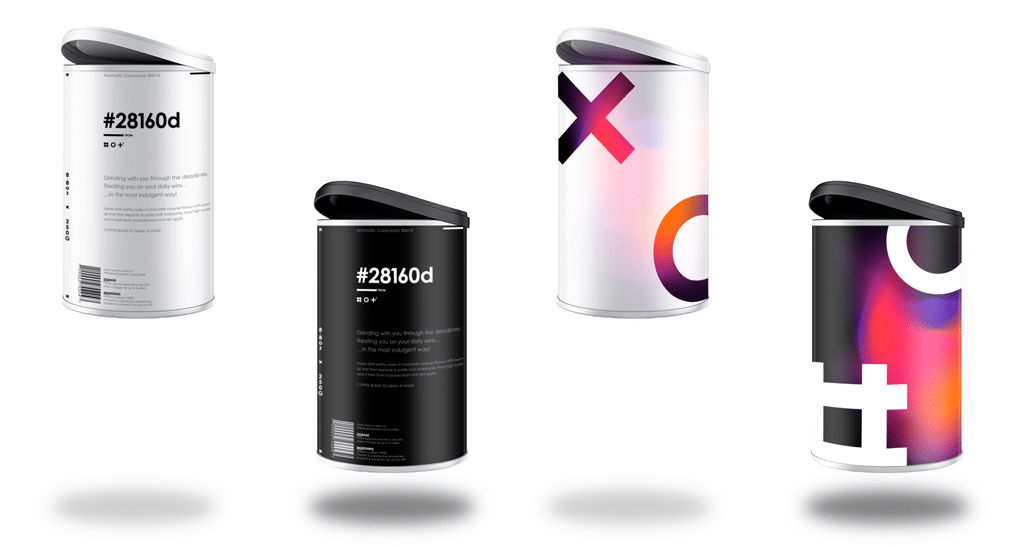
And so additional revenue streams for the company became offering branded artisan coffee. If you would have asked designers what they would want from their website development company they would simply say plugins, extensions, custom code or perhaps even custom websites or apps — but not coffee.
Surfacing deep insights like this will ultimately end up with you knowing what your customers want better than themselves.
And this leads to the most powerful result; it creates relevance and resonance with the target customer.
The Balancing Act

There are two ways you can go about integrating customer insights.
The Unproductive & Inefficient Way
Trying to connect every aspect of a visual design identity to customer preference rigidly will cause problems. Logos and other visual elements like patterns can’t undergo the same level of ‘informed by customer opinions’ as this will lead to designing in a straight jacket. The work results in uninspired design work with no memorable personality.
Additionally getting customers’ input for every design decision will not create an elegant solution. Asking what colour, font, imagery they prefer will result in us going back to scenario 2, where instead of yourself playing the art director the customer is — and the monstrosity is back.
User testing, iterating, re-testing, then reiterating is a formula that works well for digital product design (websites/apps). But when used in exactly THIS same manner for brand identity design, it is not as productive. This is because the goals of these two fields are vastly different.
Product design – The purpose of a digital product is to be used, much like a car, to get from A to B. It’s a tool/product that will be used by people who click buttons to get to new pages and/or purchase products/services. So understandably useability and functionality here are paramount.
Branding – The purpose of branding is to stand out and help identify one brand over another. This is done by capturing someone’s attention by being emotive. Captivating them by connecting, moving and inspiring them using language, visuals and sound.
The latter requires much more creativity and using too much of a formulaic approach can kill it. You could attempt to split test a colour or a shape of a logo. But doing so will only lead to the death of emotive aspect and will most certainly result in bland visuals. Brand design doesn’t work this way.
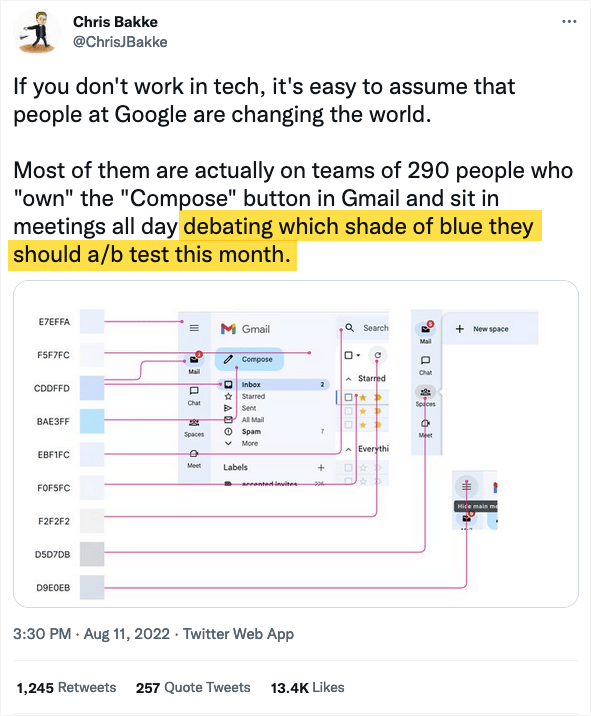
Above: Sarcasm in post implies that such terrible design — the lack of consistency and cohesion of the colour palette — could only come from excessive user testing.
Equally, we see digital product design scores well on the useability and functionality front; its primary goal. But can fail in being emotive and captivating audiences. This is especially the case when they are heavily reliant on using formulas, that may be tried and tested. The results make every single site look the same or that they are based on the same template.
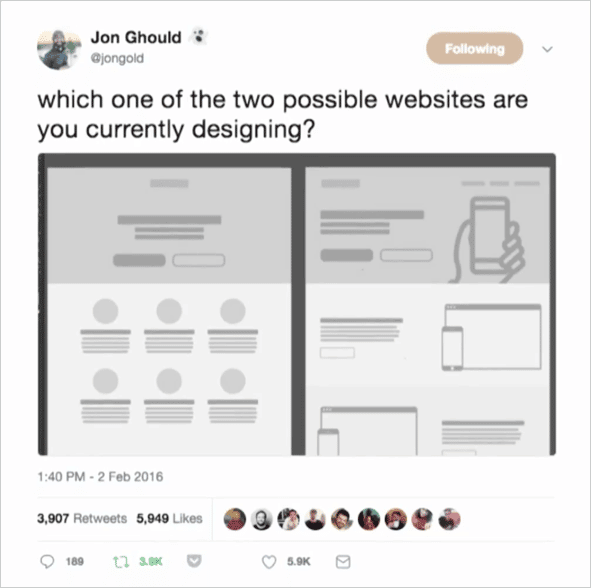
Above: Sarcasm in post implies that the limit of only two design-layout options is the result of the excessive use of formulas.
Designing like this tends to kill any surprise, delight or emotive connection.
The Productive & Efficient Way
However, this doesn’t mean brand identity design can not be informed by a customer from a broader perspective, taking customer insights to steer in the right direction.
The most productive way of using customer insights is to create a conceptual sandbox for creatives to play in. This sandbox is an overarching concept/idea which is directly connected to customer insights from the strategy. It is the bridge between strategy and design. It forms the framework in which to generate visual ideas as well as become the metric by which you measure the design.
Using this method allow your branding studio to carefully craft a few creative directions being guided by your customer insights. Option 1, 2 and 3 each as their own visual eco-system of colours, fonts, layouts, patterns, imagery etc that work in harmony. Subjectivity goes as far as choosing one objective option.
This way you can choose which option you prefer without selecting individual elements that may result in disaster when cobbled together.
This also allows your branding studio to do what they do best and bring something to the table your customers didn’t think to ask for.
We’ve all heard the famous quote (somewhat dubiously) attributed to Henry Ford, “If I had asked people what they wanted, they would have said faster horses”.
A brilliant example of this is Le Creuset, a cast iron cookware company. They partnered with StarWars.com to create limited editions of Star Wars-themed cookware which impacted the product and identity design for that campaign.

Above: Form doesn’t have to always follow function — it can also follow delight.
Again if you would have asked their target customer what they would want from their cookware brand they may have said non-stick surfaces or a heat indicator like Tefal.
You along with your branding studio are responsible for the innovation, not the customer.
“We are in the business of assertions — we can’t focus group ourselves out of this.” Seth Godin
So balance customer insights from design thinking with a creative imagination. Taking your understanding of your customer’s pain points to surprise and delight them.
In Conclusion
Key takeaways:
• Don’t be subjective. For the most part, unfortunately, your customer doesn’t care about your opinion. They want to know what your business can do for them.
• Be objective, and the way to do that is through strategy. This can be a brand strategy rooted solely in business goals – an inside-out approach. Or a customer-centric design-thinking strategy, that takes your business goals into account – an outside-in approach.
The latter recognises the objective of your company is to serve your customers and so the design follows this perspective accordingly.
• When approaching design from a strategic process, use metrics to measure its success. But don’t put yourself in a design-thinking, customer-focused, straight jacket. Ask your brand studio to bring their creative expertise to the table. Ask them to challange their designers to push creative boundaries and reach ingenious, imaginative, novel visual solutions. To surprise, delight and bring the unexpected that you hadn’t thought of.
• If you don’t have a brand strategy – get it done first. If you have gone through the strategic process, make sure your design is informed by it.
—
If the design is about changing behaviour then this is precisely what you as a pioneer with purpose is looking for. You want to instigate change, create a movement and make an impact.
To be a brand that influences and inspires, you need to understand human behaviour. This is why we at Muneebah Creative use a design thinking approach and put the customer at the heart of all our projects.
Our unique service Clarity & Craft stikes the trifecta of your business goals, customer needs and powerful evocative aesthetics.
If you need help with designing your visual identity, we can help you get Clarity to inform the Craft of your brand. Get in touch.
Following our last article, we looked at how brand values play a part...
“Creativity is a crushing chore and a glorious mystery. The work wants to...
“Resilience is the flexibility to respond to changing circumstances. It’s what allows brands...
